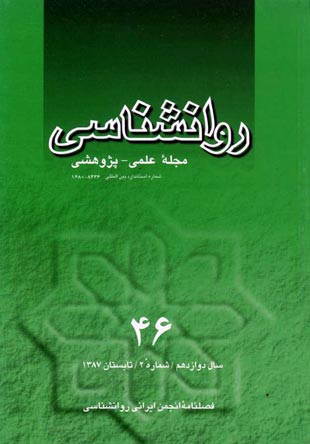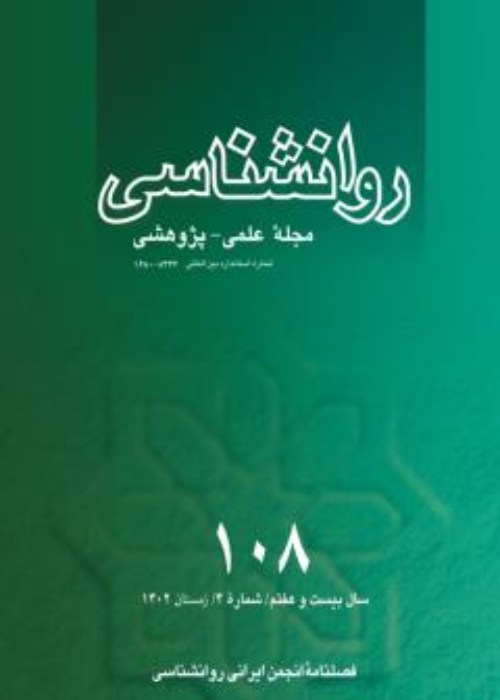فهرست مطالب

فصلنامه روانشناسی
سال دوازدهم شماره 2 (پیاپی 46، تابستان 1387)
- 120 صفحه،
- تاریخ انتشار: 1387/06/20
- تعداد عناوین: 8
-
-
صفحه 197
-
Page 122The main purpose of this study was to examine the relationship between general self-efficacy and p sychop athological symptoms in a sample of high school students. This study is ex-post research. Through random sampling, 240 third grade high school students (120 boys and 120 girls) were selected from high schools in Babol (lran). The participants completed the General Selfefficacy Scale (Sherer, et al. 1982) and the Symptom Checklist 90-Revised (Derogatis, et al. 1976). The results reve aled that self-efficacy was negatively associated with the high schoolstudents’psychopathological symp toms (soma t izat ion, obsess ivecomp ulsive, inte rp e rsonal sensit ivity, dep ression, anxiety, host ility, p hob ic, paranoid thinking, psychoticism) and low levels of gen e ral self-efficacy we re a c c omp a n ie d b y h ig h l e v e ls o f psychopathological symptoms. lt was also revealed that there was no partial gender difference between girls and boys in general self-efficacy. The implicat ions of these findings are discussed.Keywords: gen e ral self_efficacy_psychopathological symptoms_high school students
-
Page 136The aim of this study was to predict and determine the relationship between illness p ercept ion and cop ing strategies with Rheumatoid Arthritis(RA). The study was conducted with survey and cross-sectional method. Data were collected from 146 outp at ients with confirmed RA which admitted in two centers of RA in Isfahan (Iran) between 27 July and 27August 2005. Subjects responded to the Standard ized Questionnaires of Illness Perception and Cop ing St rat egies. Results showed a sign ificant correlat ion between illness perception and cop ing strategies, and also among the components of coping strategies and illnessperception.Hierarchicalmultiple regression an alysis showed t hat t he socio-demographic variables explained for %5.2, and components of illness perception explained for %10.4 of the variance in the cop ing strategies. The p resent study app roved the validity of Self-Regulat ion Model in explanation and prediction ofRA patients’ illness behavior and their cop ing strategies with RA. Moreover, this study explored the importance of illness perception as a psychosocial variable, alongside medical intervention, in management and control of RA, particularly in the onset of RA.Keywords: RheumatoidArthritis, illness perception, coping strategies
-
Page 154The present study intends to examine the role of national pride on immigration. The main question is that whether national pride in Iranian who live in Canada, who applied immigration to Canada, and those who live in Tehran are different? The sample consists of 272 Iranians (75 Iran ian immigrants who were living in Canada, 99 Iranian who applied immigration to Canada, and 98 Iranian who were living in Tehran), which filled out the International Social Survey Program (ISSP) qu est ionna ire established in Chicago University in coordination with a number of reliable international institutes (cited in Smith and Jarkko, 1998). Participants in the 3 groups were generally matched in terms of their demographic characteristics. The results ofthe present research were analyzed using ANOVA and Post Hock. Result revealed that in all items, except for two, "I’mpraud of my country’s history..." and "People should sup po rt t he ir count ry...", there were significant differences between groups; i.e. Iran ian immigrants had the lowest national pride, while non-immigrant Iranians had the highest national pride. Although national pride scores for the immigration appliers were between the immigrant and non-immigrant groups, but this group were more similar to the immigrants. The role of nat ional p ride in immigrat ion and the strategies of increasing nat ional p ride, considering the deta iled results of the research, are discussed.Keywords: national pride, identity, national identity, immigration, Iran, Canada
-
Page 170This research aimed at exploring the emotionalwords,their pleasant/unpleasant, somat ic / non - somatic and common / uncommon rat ios in Farsi d ict ionaries (Moeen, Amid and Moaser). All the entries in these three dictionarieswere investigated by t hre e ind e p end ent r efe r e es (all pschylogists) for the ir descript ive and qualitat ive cha racte rist ics. The final judgments benefited from linguistic feedbacks produced by a specialist in this field. Using SPSS for windows, data analysis showed that frequency of the pleasant emotional words were significantly less than the unpleasant ones in all the mentioned dictionaries. Also, 03% of the emotional words appeared to have somatic component(s). Moreover, it seems that the ratio of the emotional words had reduced over the time from the past to the present. The findings will be theoretically discussed from psychological point of view.Keywords: emot ional words, Farsi dictionaries, pleasant, unpleasant
-
Page 183The aim of this study was to provide st and a rd t ables for Isfa han-Fo rdyce HappinessInventory(IFHI).TheHappiness Inventory was originally develop ed by Eyse nck (1990) b ased o n fou rt e en fundamental of happiness. The inventory was translated into farsi and revised in the Un iversity of Isfahan. Considering the ava ilable literature in farsi, a sk ill of "exp ressing emot ion" was added to the inventory and it was named as IFHI. The revised inventory was applied in Isfahan universities using 727 students. As a result of transferring of the row scores to Z, T and p e rcent ile ranks, stand ard-tables for happiness skills were separatly developed. However, before develop ing the standardtables psychometiric characteristics of the IFHI were determined as; content validity of the Farsi version of Fordyce Happ iness Inventory was approved by five academic members working in the School of Education and Psychology in the University ofIsfahan; concurrent validity was established based on the correlation between the scores of the Oxford Happ iness Inventory and IFHI; validity of the inventory determined by Abedi (2002) could differentiate the depressed and non-deppresed students; and the internal reliab ility, using alp ha, in a sample of (N=727) students was 0.92, and via six-week test-retest in a sample of 50 students, it was 0.7. F in ally, educat ion al exp erts and couselors can use the IFHI for their clients as well as planning for "happiness education" in Iran.Keywords: Isfahan, Fordyce Happ iness Inventory, standardigation, validity, reliability
-
Page 197The purpose of this experiment was to study effects of governmental university (GU) students stereotypes about Islamic Azad University (IAU) and GU students on their attribution style about observed behaviors from GU and IAU students. 80 Tabriz GU students (32 males and 48 females) were assigned randomly in to four experiments. In each experiment condition, a target individual was int roduced to t he subjects wit h stereotype using consistent or inconsistent method. Then, they were requested to rate the importance of stable internal, unstable internal and external causes about the target behavior. the data were analyzed with mult iple variable analysis of var iance (MANOVA), two way analysis of variance (ANOVA), dependent t and independent t tests. The results showed that: 1) stereotype consistent behavior strongly attributed to stable internal causes, in comparison with the st ereotyp e inconsistent be havio r, 2) stereotype inconsistent behavior strongly attributed to external or unstable internal causes, in comparison with the stereotype consistent behavior,3) stereotype consistent behavior strongly attributed to the stable internal causes in comp arison with the external or unstable internal causes, and 4) stereotype inconsistent behavior strongly attributed to the external or unstable internal causes, in comparison with the stable internal causes. The results provided approval for the effects ofstereotype on causal attribution’s model, and d id emphasise on a relat ive difference between the Iranian and western societ ies, in the use of causal scheme for explanation of counter stereotype behavior.Keywords: stereotype consistent behavior, stereotype inconsistent behavior, causal attributions
-
Page 213In this research, we tried to prove that suggestions’ system could reduce job burn out as one of the methods of Part icip at ion Management. Thus 118 members of the staff working in the first, second and third caring units of Baghiyatallah hospital (Tehran, Iran) participated in this research and were divided into three groups of intervention, instruction and witness groups. Their job burn out were evaluated by Maslach Inventory in the pre-test, and then the suggestions’ system were implemented in intervent ion group while the instruction group were only trained about the suggestions’ system and the witness group remained unchanged. Three months after the implementation ofthe suggestions’ system’s, the job burn out was evaluated and analyzed. There was no significant difference among the three groups in term of the average of severity and occasions of job burn out in pre-test but in post-test there was a significant difference in terms of job burn out index between the intervention group and the two groups of instruct ion and witness (p< 0.0001). Also there was no significant difference between instruction and witness groups. The results of this research showed that the implementation of the suggestions’ system in the intervention group could reduce the job burn out of the personnel, while no significant difference was observed in the witness and instruction groups in this regard. Consequ ently, the implement at ion of suggestions’ system is introduced as a way for decreasing job burn out.Keywords: suggestion's system, job burn out, intensive care units (ICU)
-
Page 227The pu rp ose of t his study was to invest igate the relat ionsh ip b etween emp owe rment, self-efficacy and job satisfaction. Three hundred and ninety high school teachers were selected via multi-stage cluster sampling method from four regions (3, 6, 11 & 18) of Tehran. Participant responded to a Demographic Questionnaire, The School Participant Empowerment, The Sherer’s Gene ral Self-efficacy Scale, and The Minnesota Job Satisfaction Questionnaire. Data were analyzed with Pearson Correlation Coefficient, Multiple Regression analysis. Results indicate meaningful relationships between empowerment and Job satisfaction, empowerment and self-efficacy. There was no relationships between self-efficacy and Job sat isfact ion, although empowerment and self-efficacy had interaction relationship with J ob sat isfact io n. As a co n clu sion, emp owe rment and self-efficacy have interaction relationships; i.e. self-efficacy in t eachers le ads to empowerment and emp owe rment in t e ach e rs le ad s to self-efficacy and both of them, have effects on Job satisfaction. There fore, job satisfaction was increased with empowerment and self-efficacy.Keywords: empowerment, self, efficacy, job satisfaction, high school teachers


